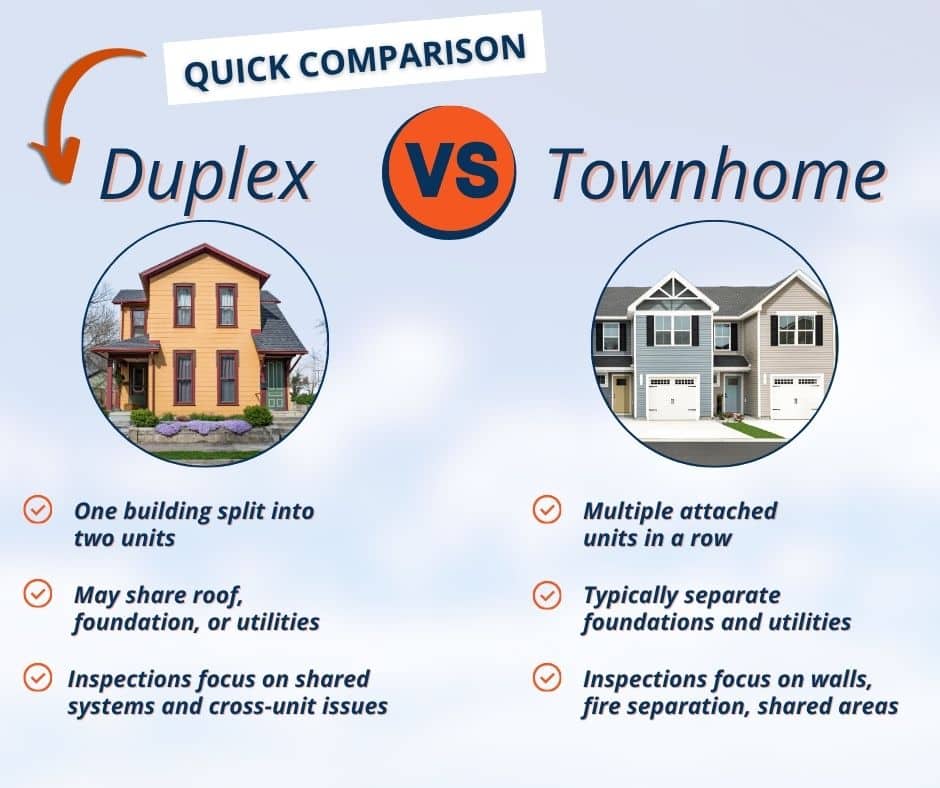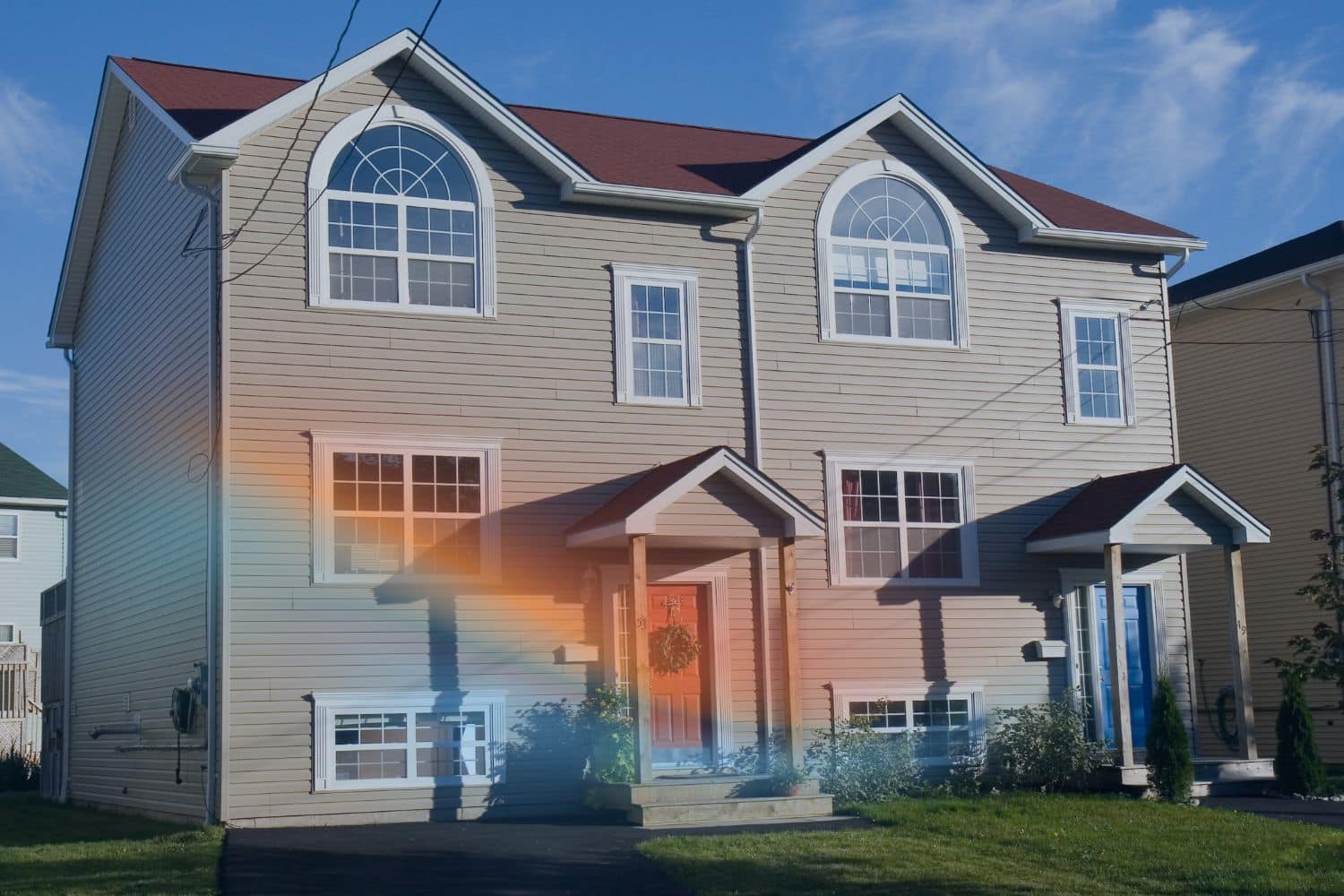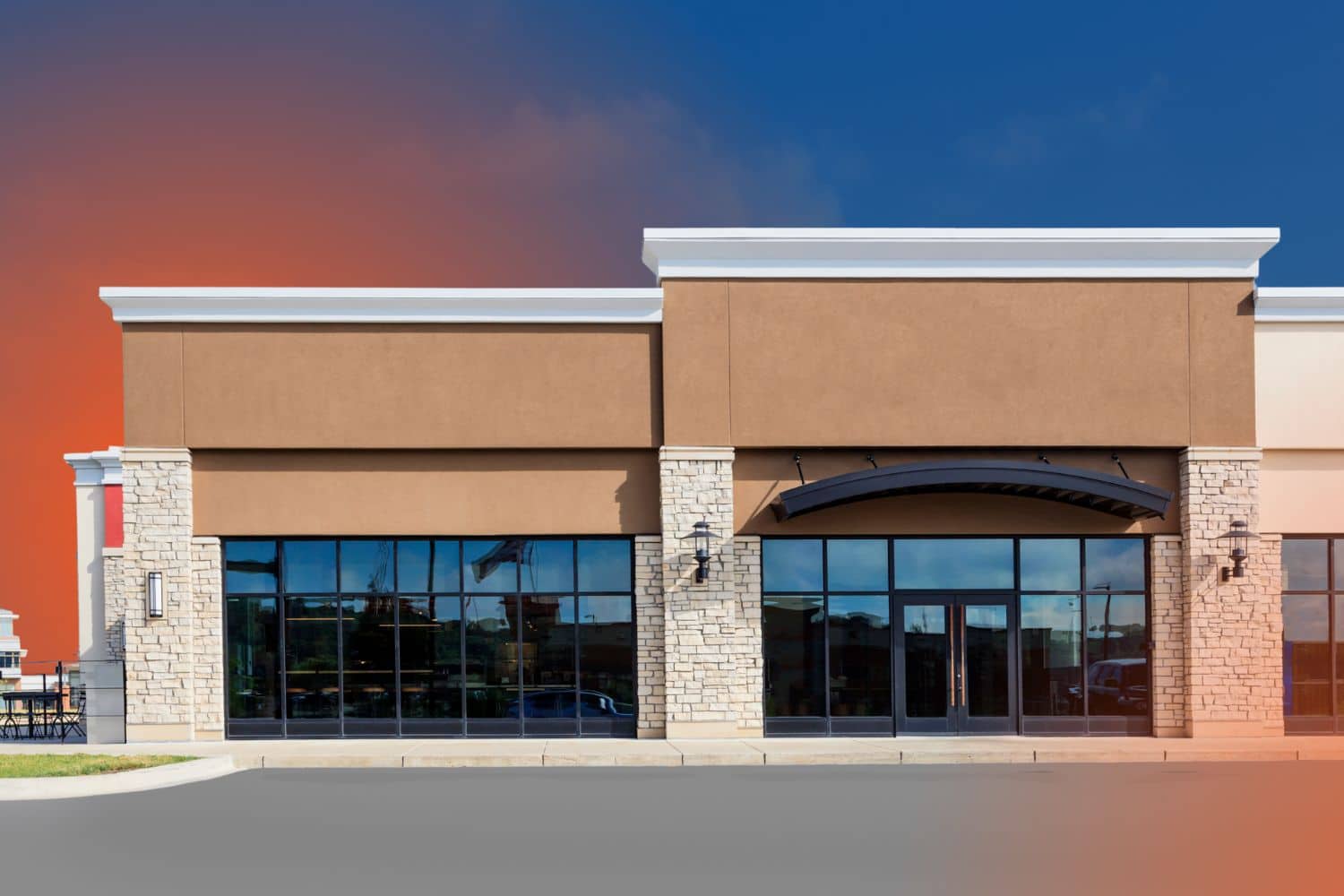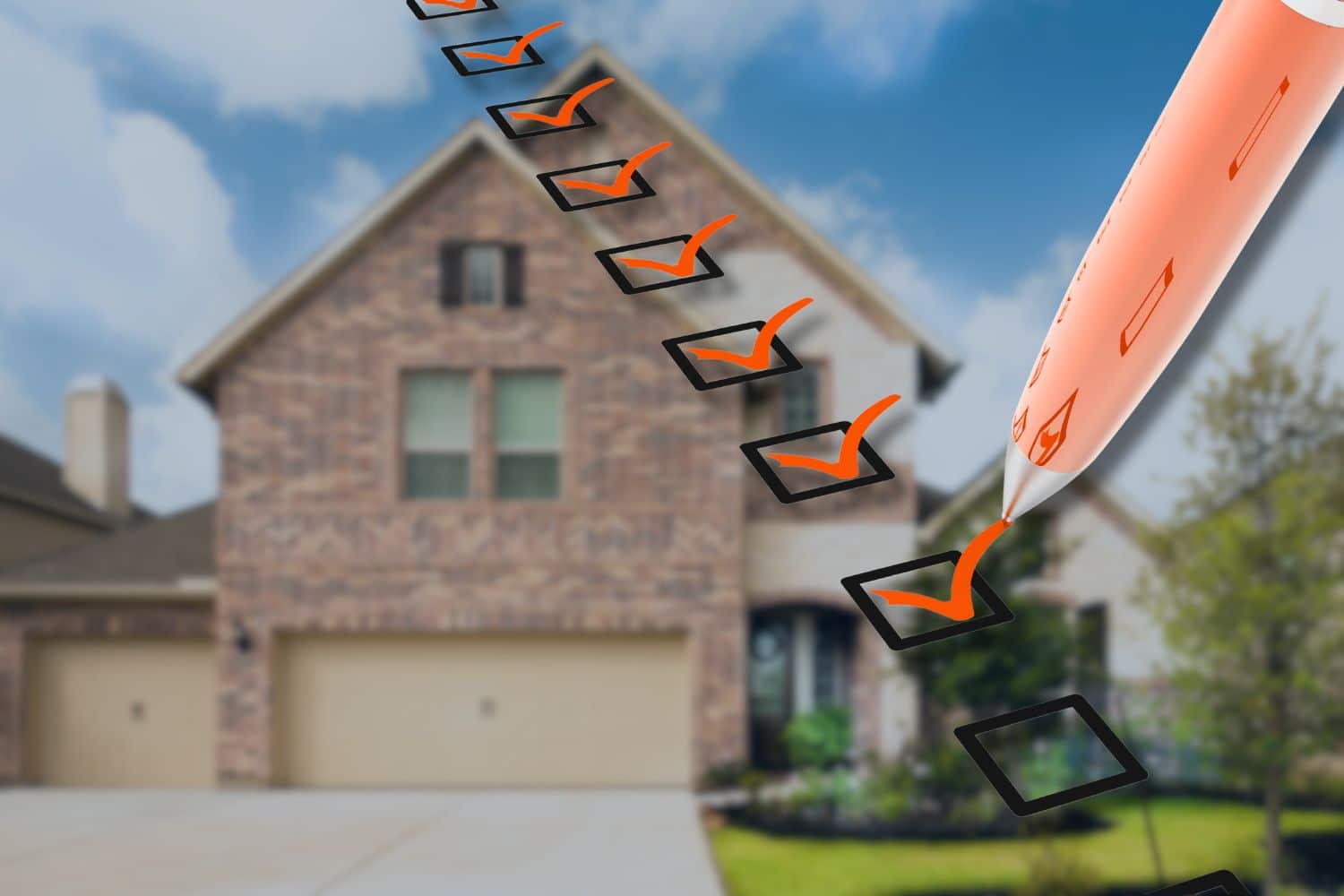It can be tricky to tell a duplex vs a townhouse. Inside, though, they’re built and owned in completely different ways, and those differences matter a lot when it’s time for an inspection.
If you’re buying or selling in Texas, understanding how these properties differ helps you catch hidden issues and avoid repair surprises.
In this guide, we’ll explain how inspections differ for a duplex vs a townhouse, what buyers should expect in Texas, and how Centex Inspection Services helps you protect your investment before closing.
Table of Contents
TogglePrimary Differences of Duplex vs Townhouses
Although both fall under multi-unit housing, duplexes and townhouses differ in structure, ownership, and inspection focus. Understanding the distinctions helps set expectations during a professional inspection.
Duplexes often share walls, plumbing, or roofs between two units. Townhouses, on the other hand, are part of longer, attached rows that involve shared walls but separate ownership and maintenance rules.
| Feature | Duplex | Townhouse |
| Design | One building divided into two units (side-by-side or top/bottom) | Multiple connected units in a row |
| Ownership | One owner or two individual owners | Firewalls, insulation, and HOA boundaries |
| Roof and Foundation | May share both | Usually separate per unit |
| Utilities | Sometimes shared | Typically individual meters |
| Exterior Maintenance | Shared responsibility | HOA or owner-managed |
| Inspection Focus | Both interior and cross-unit systems | Firewalls, insulation, HOA boundaries |
Now that you know the key differences in design and ownership, let’s explore how those details affect what inspectors look for in each property type.
Foundation and Structure
Central Texas soil is known for its heavy clay content, which expands when wet and contracts when dry. That constant cycle stresses foundations on every type of home, but it affects duplexes and townhouses differently.
For duplexes, inspectors pay attention to how the foundation ties the two units together. If one side experiences more settlement than the other, it can lead to uneven floors, wall cracks, and shifting doors in both halves.
When it comes to townhouses, the inspector checks whether foundation movement extends into shared walls or stays isolated. Expansion joints and isolation barriers help limit this transfer, but when cracks appear, they can impact multiple units in a row.
What Inspectors Look For:
- Foundation cracks or slope changes
- Separation between units or porches
- Water pooling near exterior walls
- Gaps around windows or baseboards
Centex’s local inspectors often use laser levels or moisture meters to measure subtle foundation shifts before they become serious structural problems.
A Look At Shared Walls and Fire Separation
Shared walls (called party walls) play a huge role in both duplex and townhouse safety.
For duplexes, there’s typically one shared wall between the two units. Inspectors verify that it’s properly insulated, fire-rated, and sealed to prevent sound or smoke transfer.
For townhouses, most units share walls on both sides. This increases the risk of fire spread if barriers are incomplete or breached by renovations. During inspections, Centex checks whether these walls extend fully from the foundation to the roof and whether outlets or vents compromise the barrier.
Checklist:
- Fire-rated drywall or masonry materials
- Proper sealing around electrical boxes
- Insulation continuity between units
- Soundproofing integrity
If fire barriers are missing or damaged, inspectors note the concern in the report so owners can work with contractors or their HOA to address it.

The Roof and Attic Design
Roofing is one of the biggest differences in inspection approach.
Duplex Roofs:
- Usually, a single structure covering both units
- Shared ridges mean leaks can travel between sides
- Inspectors identify where repair responsibility overlaps
Townhouse Roofs:
- Usually managed by an HOA or individually owned
- May connect with neighboring roofs through flashing
- Inspectors look for pooling water and missing sealant between units
In Central Texas, hail and high winds can wear down shingles quickly. Centex inspectors assess roof age, shingle integrity, and drainage slope to prevent future leaks or moisture intrusion into shared walls and attics.
Electrical, Plumbing, and HVAC Systems
Multi-unit properties often have complex mechanical layouts. Inspectors review how utilities are divided or connected between units.
Electrical:
- Duplexes may share meters or circuits, especially in older buildings.
- Townhouses usually have independent systems, but inspectors verify labeling and grounding.
Plumbing:
- Shared water lines can create cross-contamination risks.
- Inspectors look for leaks at connection points, water pressure consistency, and pipe material differences.
HVAC:
- Duplexes may have connected ductwork or condensate lines.
- Townhouses generally feature fully separate systems, but venting and condensation are still key issues.
Quick Reference Chart
| System | Duplex | Townhouse |
| Electrical panel | Shared or separate | Usually individual |
| Plumbing supply | May share main | Individual |
| HVAC system | Often shared ducts | Separate systems |
| Inspection priority | Line tracing and load check | Venting and drainage balance |
Inspecting Roof Drainage and Grading
Texas storms bring heavy rain and fast runoff. For duplexes and townhouses, proper grading and drainage are critical to keeping foundations stable.
Inspectors check that:
- Downspouts extend several feet from the foundation
- Gutters are securely fastened and not leaking at joints
- Slope directs water away, not toward neighboring units
- Landscaping isn’t trapping moisture at shared walls
Pooling near shared foundations is one of the most common issues Centex reports. It can lead to erosion, soil shifting, and eventually cracks in the slab.
The Exterior Walls and Siding
Exterior inspection findings can differ significantly between duplexes and townhouses.
For duplexes, inspectors look at siding consistency, sealing between units, and transitions where materials meet. If one side of the duplex is remodeled, mismatched materials can create weak points for water intrusion.
For townhouses, the HOA may handle exterior upkeep, but inspectors still note damage or rot on siding, brick veneer, or flashing. Even when owners aren’t responsible for repairs, knowing the condition helps guide future maintenance discussions with the association.
Inspectors Document…
- Cracks or peeling paint on exterior walls
- Gaps at the window flashing
- Rusting fasteners on siding panels
- Sealant deterioration around doors
Attic Ventilation and Insulation
Proper attic airflow is vital in Central Texas heat. Poor ventilation leads to heat buildup, roof wear, and high energy costs.
Inspectors check that attic baffles, vents, and insulation are balanced across both duplex sides. Townhouses, being more compact, often share rooflines, so inspectors confirm there’s no air exchange between units through the attic space.
If the fire barrier between attics is incomplete, that issue gets flagged as both a safety and efficiency concern.
Common Findings in Multi-Unit Homes
| Issue Type | Typical Cause | Found In |
| Cracks at shared foundation line | Soil movement or poor drainage | Duplexes |
| Leaks at roof joints | Damaged flashing | Both |
| Incomplete fire barriers | Attic or wall renovations | Both |
| Outdated electrical panels | Original build or uneven upgrades | Duplexes |
| Water intrusion at siding joints | Improper sealing | Townhouses |
These are among the most frequent issues Centex inspectors and other industry professionals uncover in duplex and townhouse inspections across Central Texas.
Maintenance Responsibilities and HOAs
For duplexes, ownership structure determines maintenance. If both sides are owned by one investor, inspection reports are holistic. If each side has a separate owner, Centex highlights which issues affect shared components that require joint cooperation.
Townhouses often have HOAs, and inspectors clarify which components fall under HOA coverage (roofing, exterior walls) versus homeowner coverage (interior plumbing, HVAC, attic insulation).
Having this clarity before purchase helps homeowners plan for realistic upkeep costs and avoid disputes later.

A Note on Resale and Long-Term Value
Homes with clear inspection histories tend to sell faster and hold higher value. A professional inspection verifies that shared systems are safe and compliant, something buyers especially want when purchasing attached housing.
A townhouse attracts more first-time buyers who prefer lower maintenance, vs a duplex, drawing investors looking for rental income. In both cases, inspection results influence negotiations, insurance rates, and future ROI.
Centex’s detailed reports help buyers understand exactly what they’re purchasing, from the condition of each unit to the status of shared walls, roofs, and utilities.
Related Questions
What’s Included in a Duplex vs Townhouse Inspection?
We review shared walls, separate utilities, fire-separation systems, foundation issues, and individual unit conditions to give both owners and buyers a full picture of duplex and townhouse performance.
Why Should I Schedule an Annual Maintenance Inspection?
Even well-maintained homes benefit from yearly checks. We evaluate roofs, HVAC, plumbing, grading, and other systems to uncover issues before they escalate into major repairs.
What are Wood-Destroying Insect (WDI) Reports, and Do I Need One?
A WDI inspection looks for termites, carpenter ants, and wood-decaying organisms. It’s often required in contracts and protects buyers and sellers against unseen pest damage.
When to Call a Professional
If you’re buying, selling, or maintaining a duplex or townhouse in Central Texas, a professional inspection is the best first step. Shared systems and ownership lines make these properties more complex than single-family homes.
Centex Inspection Services provides detailed reports with photos, clear findings, and repair recommendations that fit local building conditions. Their inspectors understand how Texas soil, humidity, and construction methods affect multi-unit housing.
A qualified inspection helps you:
- Identify safety or structural risks
- Separate shared and individual repair needs
- Negotiate with confidence
- Protect your long-term investment
Conclusion
Although both share walls and similar appearances, the inspection needs of a townhouse vs a duplex are not the same. From foundation cracks to roof drainage, understanding how these structures differ helps buyers, sellers, and investors make smarter decisions.
Centex Inspection Services brings deep experience with duplex and townhouse inspections across Central Texas, giving homeowners clear answers and long-term confidence in their properties.
Schedule your inspection today and discover how expert insight can help you make your next move with certainty.




